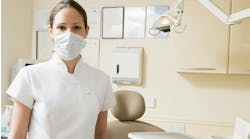FORT COLLINS, Colorado-- Zila, a leader in the prevention and detection of oral diseases, has introduced an angled exam mirror as part of the ViziLite Plus oral lesion identification and marking system. The autoclavable mirror attaches to the top of the ViziLite Plus lightstick retractor and hleps enhance dental professionals’ ability to see oral lesions during a comprehensive oral cancer screening procedure.“Early diagnosis is essential for improving the oral cancer survival rate,” said Dr. Nelson Rhodus, professor at the University of Minnesota School of Dentistry. “Using an oral cancer screening tool, such as ViziLite Plus, greatly increases the ability to confirm the presence of cancerous lesions, and improve treatment outcomes for patients.”Statistics from SEER data and the Oral Cancer Foundation show that approximately 100 people in the United States are diagnosed with oral cancer every day. Seventy percent of these cases will be diagnosed at a late stage, which partially accounts for a poor five-year survival rate of only 60%.“Most of the progress which has been made in the survival rates of all cancers has been through early detection,” said Steve Garrett, DDS, vice president – clinical development for TOLMAR, parent company of Zila. “Oral cancer should not hold the high position it does as a killer. When it is caught early, it is 80 to 90% curable.”In the U.S., oral cancer accounts for approximately 3% of all cancers but survival rates are among the lowest of major cancers. Approximately 9,000 deaths occur from oral cancer each year, making it more deadly than breast cancer, cervical cancer, and prostate cancer.With the release of the new angled exam mirror, Zila hopes to not only improve the rate of early detection of oral lesions, but also to underscore the importance of annual oral cancer screenings, especially for at-risk patients. Ninety-five percent of oral cancers occur in patients 40 and older, with those at highest risk being smokers and chronic alcohol consumers age 65 and older. Research from Johns Hopkins and other institutions suggests that the human papilloma virus, best known as the primary cause of cervical cancer, may also cause certain types of oral cancer.Screening for oral cancer is a simple noninvasive procedure that can be performed quickly and at minimal cost to the patient; it is often covered by dental insurance.For more information, go to www.zila.com.To read more about Zila, go to Zila.To comment on this product, go to community.pennwelldentalgroup.com/.References available upoon request from company.
Latest
Latest






